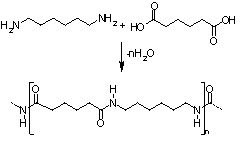Nylon
| Nylon | |
|---|---|
| Density | 1150 kg/m3 |
| Electrical conductivity(σ) | 10-12 (m·ohm)-1 |
| Thermal conductivity | 0.25 W/(m·K) |
Nylon is a synthetic polymer, a plastic, invented on February 28, 1935 by Wallace Carothers at DuPont of Wilmington, Delaware, USA. The material was announced in 1938 and the first nylon products; a nylon bristle toothbrush made with nylon yarn (went on sale on February 24, 1938) and more famously, women's stockings (went on sale on May 15, 1940). Nylon fibres are now used to make many synthetic fabrics, and solid nylon is used as an engineering material.

Chemistry
Nylon is made of repeating units with amide linkages between them: hence it is frequently referred to as a polyamide. This is a more correct nomenclature, though still somewhat flawed. There are several different versions of these "nylons", which include various polyamides made using mono- or diacid and mono- or diamine monomers. The numbers usually appended to the "nylon" or "PA" part refer to the number of CH "units" between the reactive ends of the monomer. It was the first synthetic fibre to be made entirely from inorganic ingredients: coal, water and air. These are formed into two intermediate chemicals, known as monomers, which then react to form long polymer chains.
Most types of nylon are condensation polymers, formed by reacting almost exactly equal parts of a diamine and a dicarboxylic acid, so that peptide bonds form on each end of a given monomer in a process analogous to biological polypeptide formation. The most common variant is nylon 6,6, also called nylon 66, which refers to the fact that both the diamine (hexamethylene diamine) and the diacid (adipic acid) have 6 carbon backbones. The diacid and diamine units alternate in the polymer chain. Therefore, unlike natural polyamides like proteins, the direction of the amide bond reverses at each bond.
Another common nylon is nylon 6 or polycaprolactam. It is special because it's not a condensation polymer, but instead is formed by ring-opening polymerization of caprolactam. In this process, the peptide bond within the caprolactam molecule is broken, with the active groups on each side re-forming two new bonds as the monomer becomes part of the polymer backbone. In this polymer, all amide bonds lie in the same direction, but this does not cause a major divergence from the properties of nylon 6,6.
In keeping with this nomenclature, "Nylon 6,12" or "PA-6,12" consists of a polymer based upon a 6-CH diamine, and a 12-CH diacid. You can extrapolate from this to N-6,11; N-10,12; etcetera. Other "nylons" or "polyamides" include copolymerized carboxylic acid/diamine products that are NOT based upon the monomers listed above. For example, some "nylon" polymers are polymerized with the addition of diacids like terephthalic acid or isophthalic acid (more commonly associated with polyesters); copolymers of N66/N6; copolymers of N66/N6/N12; and others.
Historical uses
During World War II, nylon replaced Asian silk in parachutes. It was also used to make tires, tents, ropes, ponchos, and other military supplies. It was even used in the production of a high-grade paper for US currency. At the outset of the War, cotton accounted for more than 80 percent of all fibres used, and manufactured and wool fibres accounted for the remaining 20 percent. By August, 1945, manufactured fibres had risen to 25 percent, and cotton had dropped to 75 percent.
Some conspiracy theorists surmise that cannabis sativa was made illegal because the fibres from the hemp plant, used for fabrics and ropes, were in strong competition with nylon. However, nylon fiber is more than twice as strong as hemp fiber and weighs 25% less. While hemp was originally used in climbing rope, it is now virtually unused in modern climbing, including countries where cannabis is legal.
Oddly enough, some of the terpolymers based upon nylon are used every day in packaging. In fact, one use of nylon polymers is in meat wrappings. This usage includes some sausage/meat sheaths.
Etymology
There is no evidence for the popular belief that "nylon" is a contraction of "NY" (for "New York") and "Lon" for "London", the two cities where the material was first manufactured. In 1940 John W. Eckelberry of DuPont stated that the letters "nyl" were arbitrary and the "on" was copied from the names of other fibres such as cotton and rayon. A later publication by DuPont (Context, vol. 7, no. 2, 1978) explained that the name was originally intended to be "No-Run" ("run" in this context meaning "unravel"), but was then modified to avoid making such an unjustified claim and to make it sound better. The story goes that Carothers changed one letter at a time until DuPont's management were satisfied.
Another popular belief is that nylon stands for "now you, lazy old nippon," as nylon was developed in the 1930s. In this sentence nippon stands for Japan, as in the 1930s, the decade in which nylon was developed, a chemical "war" was taking place between the US and Japan.
Even though the word nylon was coined, it was never trademarked.
Uses
- nylon fiber
- stockings
- leggings
- pantyhose (called tights in the UK)
- toothbrush bristles
- fishing lines
- nets
- carpet fibre
- airbag fibre
- auto parts (intake manifolds, gas tanks)
- slings and rope used in climbing gear
- machine parts, such as gears and bearings
- parachutes
- classical and flamenco guitar strings
- jackets
